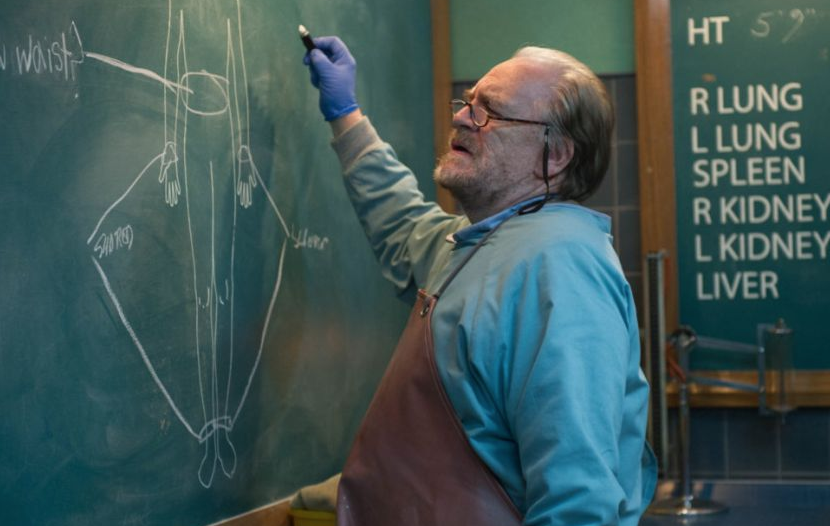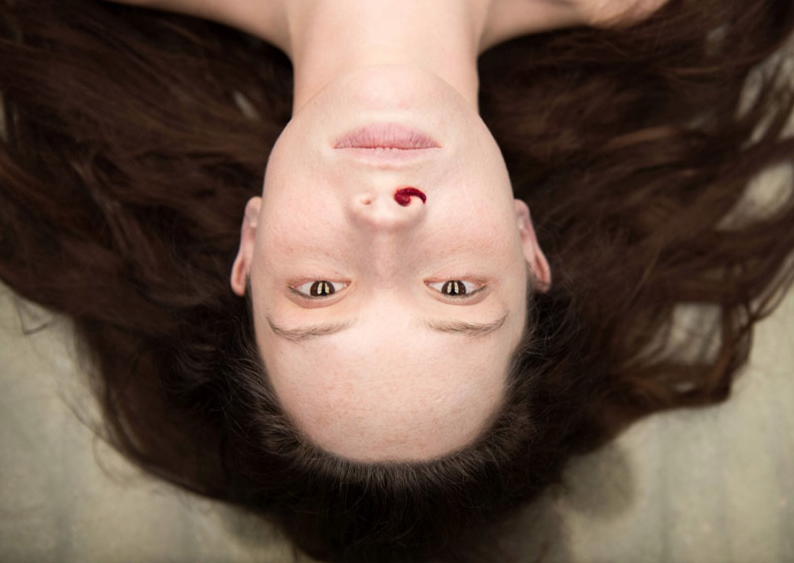The Art of Playing Dead in ‘The Autopsy of Jane Doe’
There are two exceptional establishing shots at the start of director André Øvredal‘s disturbing chiller The Autopsy of Jane Doe. First, the site of a grisly murder scene in a modest Virginian home where, after three bodies are found strewn mutilated about the house, a nude woman is found partially buried in the dirt of the basement floor. The second is the numerous wood paneled halls leading to the sterile autopsy room in the lower level of the Tilden Funeral Home where this girl will eventually come to be.
With slow methodical camera movements and low floor level angels, these brief walkthroughs deftly deliver us into the coming creepy world where things are not as they seem. It’s these early stages that are the film’s highlight and signature of the director’s visual style.
So the story. After these intros, we meet local coroner Tommy Tilden (Brian Cox) and his certified medical assistant son, Austin (Emile Hirsch). The two are finishing up on a corpse in the second site we visited, Austin’s girlfriend Emma (Ophelia Lovibond) popping by, ready for her night out at the movies.

In comes Sheriff Burke (Michael McElhatton), pushing a gurney with the body of the girl found in the basement, needing the Tildens to do what they can in figuring out who she is and how she died, all by morning. Austin cancels his date and the men go to work, starting the deliberate and precise inspection of the corpse, one that appears on the surface free of any markings or signs of trauma. What they find, however, is a nightmare of sinister evil that leads them on a destructive path of horror.

First of all, if you aren’t familiar with Norwegian filmmaker Øvredal, this will be a good place to start, his first English-language entry. Many might know him already from his excellent monster movie Trollhunter, which is one of the best ever made in the found footage genre. Here, he wanted to expand on the theme, keeping the trappings of a mostly single-setting drama with the natural steady reveal of the mystery punching up the story. It works for the most part as the first two-thirds especially are just coated in terrific tension. Still, the reasons behind who Jane Doe is and the consequence of such are far more suited to fans of one particular genre than another, the realist cinema fan looking for more logical explanations needing to check out early.
Either way, let’s talk about the body. She’s played by Olwen Catherine Kelly, an Irish model who spends nearly the entire film prone and nude on the embalming table. Would seem like an unremarkable thing and well, sort of necessary given the part she’s playing, but the mere fact that a living, breathing woman is playing the part of the dead body is what’s important. While Øvredal could have easily used a life-like prosthetic (a common practice with movie corpses … and used occasionally here for some obvious reasons), he instead decided to cast a real girl as the titular Jane Doe. It’s a decision that pays off very well with Kelly giving the entire experience a deeply distressing feeling.

Using her yoga skills and shallow breathing, Kelly manages to play dead with a kind of ironical lifelike fluidity. Wildly convincing, there’s always this creepy tease in the first half that maybe she isn’t, something Øvredal surely expects from his audience, primed by a trope of awakening corpses in horror movies. There are moments when the camera sits above her and looks down on her face when you can ‘feel’ something about her, a pain, a knowing, a sense of eerie belonging that no rubber dummy could have accomplished. That’s all Kelly doing, well, absolutely nothing, just laying there acting … dead. Think how effective she is in getting us there without using a single word or moving a muscle. That’s not happenstance of coincidence or even plain luck. That’s Kelly.
In fact, Kelly’s presence is so profoundly strong throughout, one almost loses focuses of the ‘alive’ actors in the scene, your anticipation of something sure to happen and her ability to keep that triggered while laying perfectly still, making The Autopsy of Jane Doe so significant. Even once past the sort of predictable finish that slips into more conventional storytelling, it remains Jane Doe who is the most compelling character, and rightfully (purposefully) so. You can’t take your eyes off her.
Playing dead is surely not an easy thing to do. Who here watches movies by looking at ‘dead’ characters and noticing that they’re still breathing? Those actors are on screen for only a few moments. Kelly is the subject of the entire film, and while, yes, the camera isn’t on her nonstop for it all, she’s in the movie for long lengths of screen time, at times fully exposed in every sense of the word. It’s a strangely fearless performance that is easy to go unnoticed, which is in itself, a remarkable achievement. Watch this movie if anything, only for her. She makes an art of playing dead.
